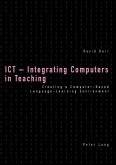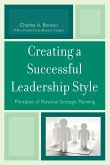John M. Brucato
Creating a Learning Environment
An Educational Leader's Guide to Managing School Culture
John M. Brucato
Creating a Learning Environment
An Educational Leader's Guide to Managing School Culture
- Broschiertes Buch
- Merkliste
- Auf die Merkliste
- Bewerten Bewerten
- Teilen
- Produkt teilen
- Produkterinnerung
- Produkterinnerung
Creating a Learning Environment addresses the need to: Assess the culture that defines a school's environment Reflect on the variables which can improve/degrade the culture Determine what practices to employ in order to make necessary improvement
Andere Kunden interessierten sich auch für
![ICT - Integrating Computers in Teaching ICT - Integrating Computers in Teaching]() David BarrICT - Integrating Computers in Teaching80,30 €
David BarrICT - Integrating Computers in Teaching80,30 €![Creating a Successful Leadership Style Creating a Successful Leadership Style]() Charles A. BonniciCreating a Successful Leadership Style51,99 €
Charles A. BonniciCreating a Successful Leadership Style51,99 €![Creating a Successful Leadership Style Creating a Successful Leadership Style]() Charles A. BonniciCreating a Successful Leadership Style96,99 €
Charles A. BonniciCreating a Successful Leadership Style96,99 €![Creating Partnerships with Parents Creating Partnerships with Parents]() Donald LuederCreating Partnerships with Parents78,99 €
Donald LuederCreating Partnerships with Parents78,99 €![The Ratings of Learning Environment and Students' Academic Performance The Ratings of Learning Environment and Students' Academic Performance]() Nwanna PerpetualThe Ratings of Learning Environment and Students' Academic Performance47,99 €
Nwanna PerpetualThe Ratings of Learning Environment and Students' Academic Performance47,99 €![Impact of Physical Infrastructure on School Learning Environment Impact of Physical Infrastructure on School Learning Environment]() Bijaya NepalImpact of Physical Infrastructure on School Learning Environment51,99 €
Bijaya NepalImpact of Physical Infrastructure on School Learning Environment51,99 €![Towards an Intelligent Online Learning Environment Towards an Intelligent Online Learning Environment]() Sofia Balula DiasTowards an Intelligent Online Learning Environment27,99 €
Sofia Balula DiasTowards an Intelligent Online Learning Environment27,99 €-
-
-
Creating a Learning Environment addresses the need to: Assess the culture that defines a school's environment Reflect on the variables which can improve/degrade the culture Determine what practices to employ in order to make necessary improvement
Produktdetails
- Produktdetails
- Verlag: R&L Education
- Seitenzahl: 146
- Erscheinungstermin: 28. Januar 2005
- Englisch
- Abmessung: 229mm x 152mm x 8mm
- Gewicht: 223g
- ISBN-13: 9781578861903
- ISBN-10: 157886190X
- Artikelnr.: 20992514
- Herstellerkennzeichnung
- Libri GmbH
- Europaallee 1
- 36244 Bad Hersfeld
- gpsr@libri.de
- Verlag: R&L Education
- Seitenzahl: 146
- Erscheinungstermin: 28. Januar 2005
- Englisch
- Abmessung: 229mm x 152mm x 8mm
- Gewicht: 223g
- ISBN-13: 9781578861903
- ISBN-10: 157886190X
- Artikelnr.: 20992514
- Herstellerkennzeichnung
- Libri GmbH
- Europaallee 1
- 36244 Bad Hersfeld
- gpsr@libri.de
John M. Brucato
Part 1 Foreword by Phillip F. Flaherty
Part 2 Preface
Part 3 Acknowledgments
Part 4 Introduction
Part 5 Part I: The Problem
Chapter 6 1. Assessing School Culture: Putting the Horse before the Cart
Part 7 Part II: Beginnings
Chapter 8 2. The Six Key Questions to Assessing School Culture
Chapter 9 3. Why We Need to Read, Write, and Reflect: The Journal
Chapter 10 4. Climate-Focused Leaders: The Profile
Chapter 11 5. The Guiding Principles of Success
Chapter 12 6. Building an Administrative Team: The Foundation of a Well-Run
School
Chapter 13 7. Climate Control: All Educators on Board
Part 14 Part III: New Beginnings
Chapter 15 8. Swinging the Balance
Chapter 16 9. Clarity of Expectations
Chapter 17 10. The Faculty Manual
Chapter 18 11. Growth and Excellence Are Not Optional
Chapter 19 12. Teacher Appreciation
Chapter 20 13. The Student Body: The Driving Force of School Reform
Chapter 21 14. How to Develop a Support Staff that Becomes the Glue that
Holds Your School Together
Part 22 Appendix I: How to Develop a School Culture that Reduces Discipline
Problems and Enhances Safety
Part 23 Appendix II: How to Deal More Effectively with Difficult Parents
Part 24 Appendix III: How to Deal with Difficult Teachers
Part 25 Appendix IV: How to Achieve Success with the Next Level of Student
Discipline
Part 26 Appendix V: Developing an Administrator-Friendly Student/Parent
Handbook
Part 27 Appendix VI: Seven Reasons Why School Administrators Cannot Turn
Their Backs on Issues of Nonschool Conduct
Part 28 Appendix VII: You Make the Call
Part 29 References
Part 30 About the Author
Part 2 Preface
Part 3 Acknowledgments
Part 4 Introduction
Part 5 Part I: The Problem
Chapter 6 1. Assessing School Culture: Putting the Horse before the Cart
Part 7 Part II: Beginnings
Chapter 8 2. The Six Key Questions to Assessing School Culture
Chapter 9 3. Why We Need to Read, Write, and Reflect: The Journal
Chapter 10 4. Climate-Focused Leaders: The Profile
Chapter 11 5. The Guiding Principles of Success
Chapter 12 6. Building an Administrative Team: The Foundation of a Well-Run
School
Chapter 13 7. Climate Control: All Educators on Board
Part 14 Part III: New Beginnings
Chapter 15 8. Swinging the Balance
Chapter 16 9. Clarity of Expectations
Chapter 17 10. The Faculty Manual
Chapter 18 11. Growth and Excellence Are Not Optional
Chapter 19 12. Teacher Appreciation
Chapter 20 13. The Student Body: The Driving Force of School Reform
Chapter 21 14. How to Develop a Support Staff that Becomes the Glue that
Holds Your School Together
Part 22 Appendix I: How to Develop a School Culture that Reduces Discipline
Problems and Enhances Safety
Part 23 Appendix II: How to Deal More Effectively with Difficult Parents
Part 24 Appendix III: How to Deal with Difficult Teachers
Part 25 Appendix IV: How to Achieve Success with the Next Level of Student
Discipline
Part 26 Appendix V: Developing an Administrator-Friendly Student/Parent
Handbook
Part 27 Appendix VI: Seven Reasons Why School Administrators Cannot Turn
Their Backs on Issues of Nonschool Conduct
Part 28 Appendix VII: You Make the Call
Part 29 References
Part 30 About the Author
Part 1 Foreword by Phillip F. Flaherty
Part 2 Preface
Part 3 Acknowledgments
Part 4 Introduction
Part 5 Part I: The Problem
Chapter 6 1. Assessing School Culture: Putting the Horse before the Cart
Part 7 Part II: Beginnings
Chapter 8 2. The Six Key Questions to Assessing School Culture
Chapter 9 3. Why We Need to Read, Write, and Reflect: The Journal
Chapter 10 4. Climate-Focused Leaders: The Profile
Chapter 11 5. The Guiding Principles of Success
Chapter 12 6. Building an Administrative Team: The Foundation of a Well-Run
School
Chapter 13 7. Climate Control: All Educators on Board
Part 14 Part III: New Beginnings
Chapter 15 8. Swinging the Balance
Chapter 16 9. Clarity of Expectations
Chapter 17 10. The Faculty Manual
Chapter 18 11. Growth and Excellence Are Not Optional
Chapter 19 12. Teacher Appreciation
Chapter 20 13. The Student Body: The Driving Force of School Reform
Chapter 21 14. How to Develop a Support Staff that Becomes the Glue that
Holds Your School Together
Part 22 Appendix I: How to Develop a School Culture that Reduces Discipline
Problems and Enhances Safety
Part 23 Appendix II: How to Deal More Effectively with Difficult Parents
Part 24 Appendix III: How to Deal with Difficult Teachers
Part 25 Appendix IV: How to Achieve Success with the Next Level of Student
Discipline
Part 26 Appendix V: Developing an Administrator-Friendly Student/Parent
Handbook
Part 27 Appendix VI: Seven Reasons Why School Administrators Cannot Turn
Their Backs on Issues of Nonschool Conduct
Part 28 Appendix VII: You Make the Call
Part 29 References
Part 30 About the Author
Part 2 Preface
Part 3 Acknowledgments
Part 4 Introduction
Part 5 Part I: The Problem
Chapter 6 1. Assessing School Culture: Putting the Horse before the Cart
Part 7 Part II: Beginnings
Chapter 8 2. The Six Key Questions to Assessing School Culture
Chapter 9 3. Why We Need to Read, Write, and Reflect: The Journal
Chapter 10 4. Climate-Focused Leaders: The Profile
Chapter 11 5. The Guiding Principles of Success
Chapter 12 6. Building an Administrative Team: The Foundation of a Well-Run
School
Chapter 13 7. Climate Control: All Educators on Board
Part 14 Part III: New Beginnings
Chapter 15 8. Swinging the Balance
Chapter 16 9. Clarity of Expectations
Chapter 17 10. The Faculty Manual
Chapter 18 11. Growth and Excellence Are Not Optional
Chapter 19 12. Teacher Appreciation
Chapter 20 13. The Student Body: The Driving Force of School Reform
Chapter 21 14. How to Develop a Support Staff that Becomes the Glue that
Holds Your School Together
Part 22 Appendix I: How to Develop a School Culture that Reduces Discipline
Problems and Enhances Safety
Part 23 Appendix II: How to Deal More Effectively with Difficult Parents
Part 24 Appendix III: How to Deal with Difficult Teachers
Part 25 Appendix IV: How to Achieve Success with the Next Level of Student
Discipline
Part 26 Appendix V: Developing an Administrator-Friendly Student/Parent
Handbook
Part 27 Appendix VI: Seven Reasons Why School Administrators Cannot Turn
Their Backs on Issues of Nonschool Conduct
Part 28 Appendix VII: You Make the Call
Part 29 References
Part 30 About the Author








